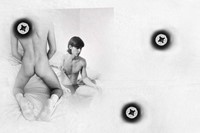Peter De Potter wants you to know he’s not a ‘collagist’, nor is he a ‘boy photographer’. “I’m an artist, or an image-maker,” he clarifies in a soft Flemish accent, speaking on FaceTime from his home and studio in Antwerp, Belgium.
De Potter first entered the limelight in the early 2000s when he collaborated and consulted with Raf Simons. Since then, his portfolio – which includes the viral album art for Kanye West’s The Life of Pablo – has had an influence on queer visual culture so vast it’s almost impossible to calculate. De Potter’s new, erotically-charged monograph Ring Light New Testament was unveiled last month, only to sell out three weeks later.
“This is already my fifth book,” he says. De Potter’s first arrived in 2016, and much like his prints, his published works have become highly covetable and prized possessions. “This [book] is a continuation, it’s not like a completely new departure at all.” It’s true that all the codes that make up the artist’s distinct output are present – his own personal photographs graphically designed with text and poetry, the emergence of skin, muscle, the nuanced still-lifes – but as the book’s title suggests, this particular project is a commentary on an ostensibly 21st-century phenomenon. “Most of my posts and most of my work are about the way people present themselves. For me, the new chapter is with platforms like TikTok and OnlyFans, where subjects go way beyond merely presenting themselves and telling you a story. They’re really performing.”
De Potter has been observing (and obsessing over) the evolution of visual culture since the dawn of social media. Initially on Tumblr, the social networking-slash-blogging site that more recently dropped from favour since its purge of sexual content, the artist found his work far-flung on curated blogs of art and so-called ‘pale boys’, inspiring countless users to adjust their tact in self-portraiture. Capturing their own De Potter-style images for the digital applause of Tumblr users, they shaped their image into an aesthetic in their own right. “These people are in a room just by themselves making something they know that the world is going to see,” he says. “That, for me, is very intriguing and very powerful.”

Now, legions of people have moved to TikTok and OnlyFans by way of sharing (and in some cases, monetising) not only their own image, but their personality too. “I encourage people to show themselves. Coming from me, that’s quite rich I know,” De Potter says. Images of the artist himself are few and far between – instead he acts almost like a panopticon tower, constantly looking out, making tributes to this shifting culture. “It’s a phenomenon that the new generation are really into speaking, talking, dancing, jerking off. I really like that this screen is sort of lifted, and it’s up to me, or you, or whoever to pick what you like and what you don’t like. I’m all for it; it’s a sense of driving forward.” Devoid of the reserved piety that many still advocate for, in our new culture of deeply personal oversharing it’s a sentiment that not everybody is comfortable with. Some say it’s a culture borne from narcissism, but it’s part of the fight for connection in an increasingly saturated digital world.
Particularly on OnlyFans, the performance becomes pornographic. “The fact that people show themselves this way, there’s a bit of a taboo. [The body is] almost like a war zone, for some reason. But now, with new technology, people are discovering that it’s actually not the devil’s playground. It’s something that’s …” he pauses to find the right words, “I was going to say empowering. I think it’s a good evolution.” But are art and pornography mutually exclusive categories? In spite of the subjects’ suggestive positioning, perfect-bound in a monograph, there is something almost innocent in De Potter’s imagery, like it’s all playacting. “Somebody like Tom of Finland, back in the day when he did his drawings, they were just for the jerk off magazines. Only 20 to 30 years later – after his death, incidentally – the art world will pick them up, and all of a sudden it was art – and that’s always really bugged me. Tom was a bonafide artist to begin with,” De Potter says. “Everybody is touched by sexuality. I think porn is very, very important. I think there’s some pornographers who, maybe without them even realising, are artists.”


Subjects interact with objects loaded with symbolism, such as a scythe “representing harvest as well as war and death.” Other items from his own collection of personal belongings become a challenge. “We have, for instance, a set of pliers, we have a motorcycle tire. How can I turn this into a performance?” Caught in the act in De Potter’s absurdist scenes, the outcome blurs the line between documentary and staging, but it’s the subjects who hold the power in their desire to be watched, and willingly, the viewer tunes in. “Everybody wants to be seen. Sometimes literally, sometimes more on a metaphorical level – but to be seen, to be noticed by millions, or by one person, I think it’s a driving lifeforce.”
Ring Light New Testament by Peter De Potter is out now.






